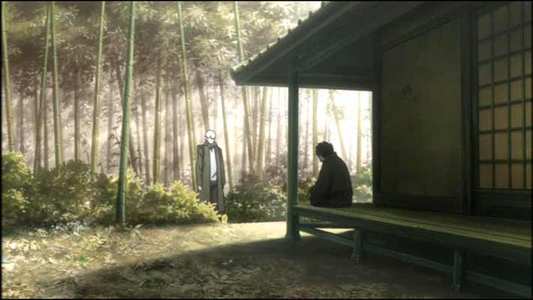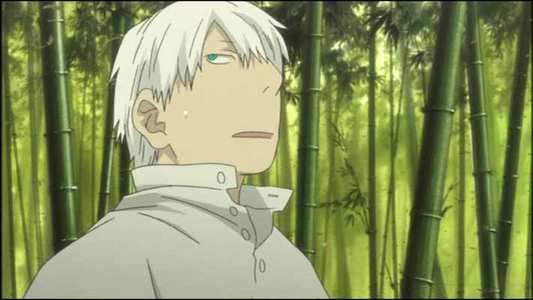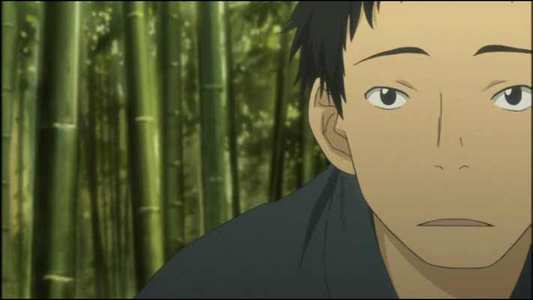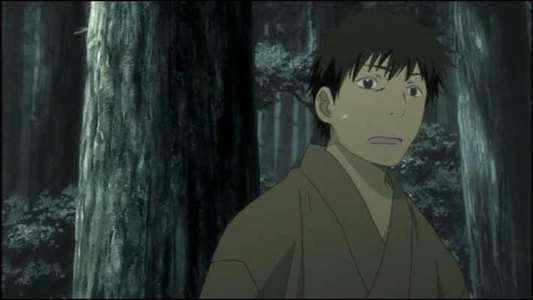Review of Mushi-shi: Volume 3
Introduction
Spooks and spectres figure strongly in Japanese folklore, there is a strong sense of spirituality and communion with nature that resonates all the way to modern entertainment, and it`s no surprise that Hollywood is now aping many Eastern horror films in order to breathe life into the putrid corpse of their entertainment industry. Naturally this fascination with the supernatural is a strong source of inspiration for manga and anime, and scarcely a year goes by that there aren`t ten or so such spooky series debuting in the UK market alone. You would think that with the abundance of vampires, ghosts, demons and spirits that there would come a point when the average anime fan would have seen it all, and would have nothing left to gain from yet another such series. But then Mushi-shi turns up for review, unlike anything I have seen before, and offering a new perspective on the supernatural.
Mushi are the most primitive of life forms. Elusive and ethereal, and existing since time immemorial, they have come to be the cause of many superstitions and supernatural legends. Ginko is a Mushi-shi, a Mushi Master. He travels the country investigating these odd creatures, and helping those people who, for good or ill wind up interacting with them. Four more episodes are presented in this eagerly awaited third volume, released by Revelation.
11. The Sleeping Mountain
Odd things are happening at a mountain by a village, for one thing a perfect hole in the middle of the peak vanishes when Ginko glances away. He offers his services to the fearful villagers who accept on hearing that he is a Mushi-shi. Apparently they had a mushi-shi of their own named Mujika, who has suddenly vanished. Mujika was the only one who could communicate with the Guardian of the mountain, no one else was permitted to go near during harvest time, and all those who have tried since Mujika`s disappearance have sickened and died. Ginko agrees to search for Mujika, and all the while, a bell tolls in the distance.
12. One-Eyed Fish
A young boy named Yoki was injured in a storm, victim of a landslide that claimed his mother. A Mushi-shi named Nui found the boy, and took him home with her to nurse back to health. Nui is an odd sort, with long white hair and a single, piercing green eye. She`s intrigued to find that the boy can also see mushi, but is determined that he leaves as soon as he is well enough. She lives alone in the forest, in a house built next to a lake teeming with mushi, and white, one-eyed fish. She tells the boy of the two types of dark mushi, and that he must avoid them. One type, the Tokoyami were responsible for luring her family away from her, which is why she lives here alone. The other type of mushi have no name, but she calls them Ginko.
13 One-Night Bridge
An unwanted arranged marriage forced a pair of lovers to try to escape from an isolated village. The girl, Hana was hesitant though, and while crossing a precarious rope bridge across a ravine, fell through the planking. Amazingly she survived though, but for the last three years she has been in a daze, unable to do anything but soak up the sun. The people of the village think she is a Tani-modori, a body without a soul.
14. Inside The Cage
Ginko has an odd encounter in a bamboo forest. A man named Kiseke asks if Ginko can guide him out to the nearest village, but they end up walking in circles. This doesn`t surprise Kiseke, but when Ginko leaves him, he has no problem finding the right path. Kiseke has been trapped in the forest for years, although it isn`t an unpleasant experience, as he has a wife and young daughter to keep him company. None of them can leave the forest, while the villagers think that he`s taken up with monsters. The mystery revolves around a strange white bamboo.

Video
Mushi-shi gets a 1.78:1 anamorphic transfer that aside from the odd artefact in the re-edited title sequence is free of any significant blemish. The transfer is as clear and sharp as NTSC-PAL gets, and the colours are lush and striking. This is an anime that takes the breath away in terms of the design and the animation. Mushi are a phenomenon strongly associated with nature, and Ginko`s travels take him to rural idylls and isolated communities in forests full of lavish natural colours. The character designs are simple but effective, but the thought gone into the animation takes it to theatrical quality. The limited palette of colours makes for an atmospheric piece, and the realisation of the ethereal mushi is stunningly accomplished. This is perhaps the most beautiful animation that I have seen this year.

Audio
You get sound in DD 2.0 stereo in English and Japanese flavours, along with translated subtitles and signs. The audio options are robust and surprisingly effective stereo tracks, with subtle sound design coming through the speakers. The effects reflect the gentle tone of the stories, and the music is atmospheric yet understated. This is a story where the sound of a footstep in snow, or the whisper of a breeze makes more impact than anything strident and obvious. It`s certainly one of the better stereo discs, but I wonder how much more effective a 5.1 soundtrack would have been.

Features
The usual suspects here include a jacket picture, trailers for School Rumble and Peach Girl, and the textless songs, although only one of the end themes is here (Mushi-shi`s episodes all get different end themes that suit their particular stories).
Just as last time, there are a couple of interviews to be getting on with.
Director Interview #4 - Sound Direction has director Hiroshi Nagahama chatting to sound director Kazuya Tanaka. Tanaka has a wide range of responsibilities, from casting, directing the voice actors, music, and sound effects, to the overall sound design, and the two go over these aspects over the 20-minute run time.
Director Interview #5 - Shooting Direction sees Nagahama joined by Yuuki Hama (Filming Director), Yui Tan (Assistant Filming Director), and Yoshihisa Oya (Technical Advisor). This lasts 25 minutes, and the four of them talk about getting the look of the show right, converting the initial drawings into animation, adding visual effects, compositing elements, and creating atmosphere. It`s surprising to learn how much effort goes into Mushi-shi, and how, unlike many other anime, the look actually varies from episode to episode.

Conclusion
If you`ve read my reviews for the first two volumes, you should know what comes next. Buy this disc. If you are an anime fan, this is a series that simply must find a home on your DVD shelf, it is that good. Mushi-shi is an ethereal, magical, atmospheric experience that is unlike anything that I have seen before. It presents its supernatural tales with an outlook based on nature and harmony that simply envelops, caresses and carries the viewer along, with its carefully structured short story format. I still find it amazing that it manages to thoroughly develop new characters, and tell rounded and intricate stories in a 25-minute run time. What`s astounding is that it does so again and again without diminishing in quality.
That quality is once again evident in the four episodes on this disc, and what makes this disc even more appealing is that despite the episodic format, we`re beginning to get some background into the world of the mushi-shi, as well some insight into Ginko himself. We learn why Ginko is a wanderer in The Sleeping Mountain. He cannot stay in one place for long, as he attracts mushi, and eventually they bring misfortune to those around him. It seems to be true of all mushi-shi, although the one we meet in this episode, Mujika has found a way to settle down. However the way in which he has done so is a tragic story in itself. Ginko wants to help Mujika, but the older mushi-shi feels that he has to atone for his past.
One-Eyed Fish is a gift for fans that have stayed with the show so far. We learn of Ginko`s past, and how he came to lose his eye, harking back to an episode on disc 1. It also explains how he came to be a mushi-shi, and we meet the woman that inspired him. I`d say One-Night Bridge would be the weakest story on the disc, although that`s only relative to the other episodes. It almost feels familiar, as if I have seen the story on an earlier disc, and it begins and proceeds in a rather predictable way. It`s when the nature of these particular mushi becomes clear that the story begins to surprise, and the ending is strong and moving.
Unpredictability certainly isn`t the final episode`s strong point either, with the story of a man bound to a certain location obvious and unchallenging. What makes Inside The Cage stand out is the strength of the characterisations, certainly the strongest such episode on this disc. While the story proceeds in such a way that I saw the ending coming well in advance, by that point I had gotten to know the characters so well, that I was still left with a lump in my throat at the end. It`s an emotionally powerful and moving episode, and easily the most impressive on an already faultless disc.
Anime may be facing a downturn in the West, exacerbated perhaps by the current economic woes in the US, but with shows of this calibre still coming to our shores, maybe the long term future of the industry isn`t as bleak as it`s made out to be. Put Mushi-shi at the top of your shopping list. If that isn`t enough, we also have the live action Mushi-shi film (directed by Katsuhiro Otomo of Akira fame) to look forward to this spring.
Your Opinions and Comments
Be the first to post a comment!